Report

Executive Summary
- The Inflation Reduction Act continues the diversification trend and has catalyzed investment in the US electric vehicle supply chain.
- Analysis suggests a sufficient supply of key minerals to meet IRA requirements for US or free-trade area sources.
- However, risks include the possibility that some regional and global supply/demand imbalances will potentially exist across the EV value chain.
- Amid uncertainties, building flexible strategies, transparency, and creating partnerships to derisk investments is key.
The Inflation Reduction Act (IRA) has attracted more than $65 billion of investment in the US electric vehicle (EV) supply chain since it was passed in August 2022, including $49 billion for new battery and battery component manufacturing. It amounts to a massive commitment to the shift away from combustion engine vehicles and to building up domestic EV manufacturing capability, right along the supply chain. This stems from the substantial tax credits offered to drivers who buy EVs and requirements that a large share of raw materials and components must be extracted and produced in the US or in Free Trade Agreement (FTA) countries. These include Canada, Australia, South Korea, and Chile.
Written in collaboration with
Written in collaboration with

The IRA provides tax credits of up to $7,500 for the purchase of new consumer and commercial light vehicles, and up to $40,000 for medium- and heavy-duty vehicles such as buses. There are also significant production incentives for manufacturers that localize each step of the EV value chain. To qualify for the consumer vehicle credit, vehicles must meet certain supply-chain criteria: Eighty percent of the value of critical minerals used to make the vehicle must be extracted or processed in the US or an FTA country by 2027, and 100% of the component value of a battery must be produced or assembled in North America by 2029. Importantly, these criteria do not apply to commercial vehicles, which could lead to supply-chain division.
The anticipated accelerated shift to EVs from internal combustion engine (ICE) vehicles resulting from the subsidies will make a significant contribution toward the US meeting its emissions-reduction targets. Analysis by our research partner RMI, an independent nonprofit focused on clean energy, predicts that the lifetime greenhouse gas (GHG) emissions of an electric vehicle that hits the road in 2024 will be around half those of a traditional ICE vehicle (see Figure 1). Localizing manufacturing in line with the IRA’s requirements could reduce this by a further 10%.
The Inflation Reduction Act will help reduce carbon emissions through a combination of faster electric vehicle adoption and value-chain localization
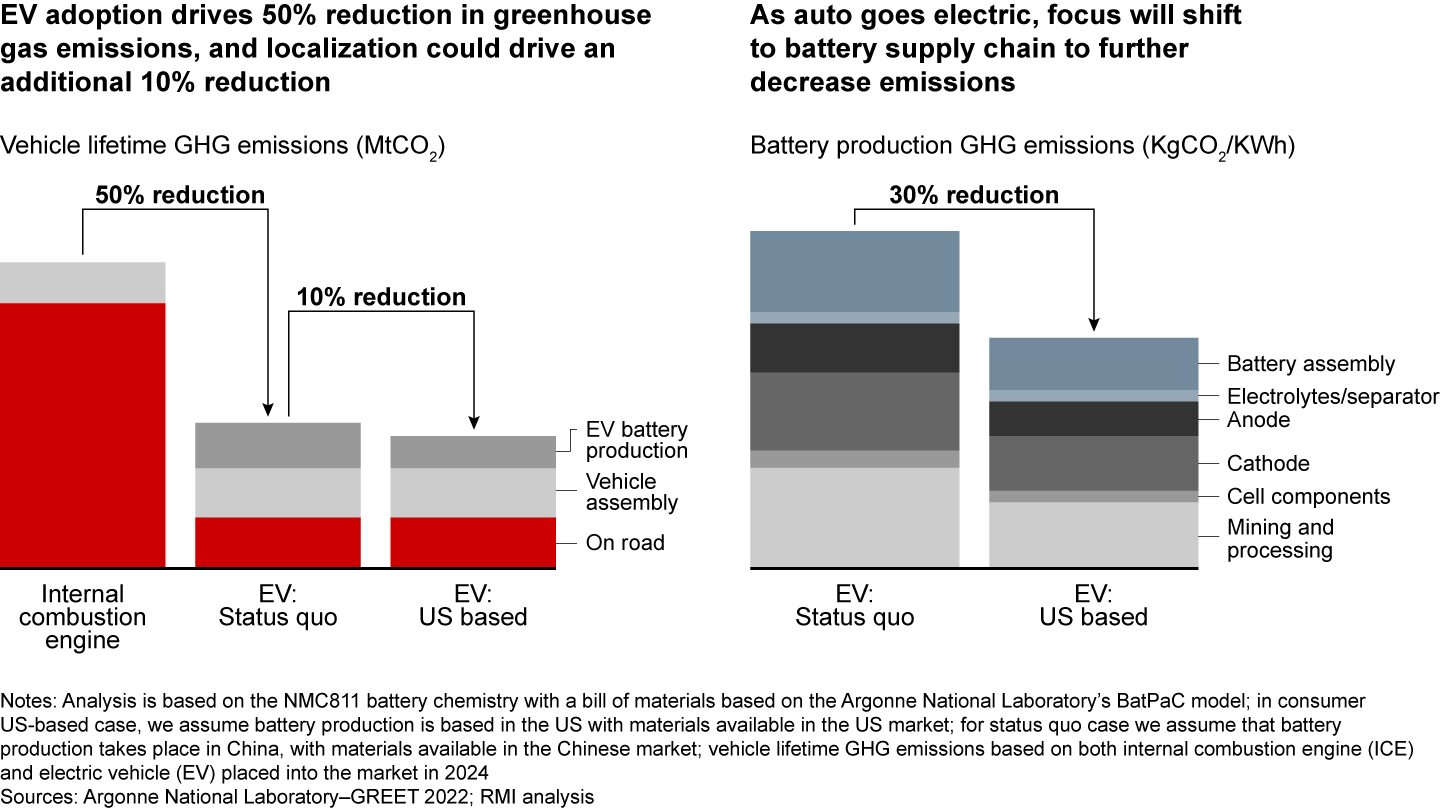
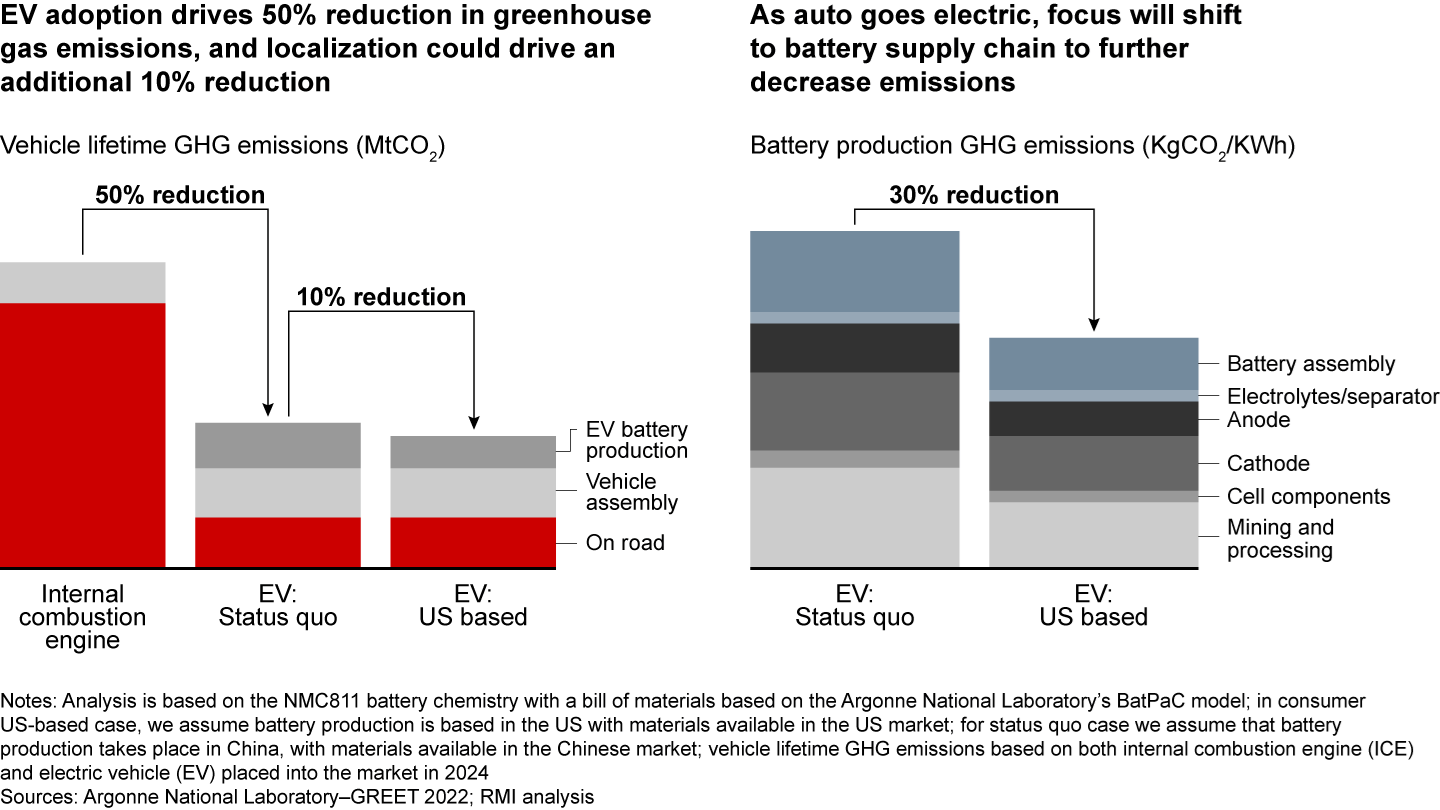
While the IRA currently offers one of the largest packages of government incentives for EVs and localized battery manufacturing, other countries are likely to move toward building more diversified EV supply chains. The European Union’s (EU) Critical Raw Materials Act, for example, commits to increasing the share of mineral extraction and processing and battery manufacturing carried out within the EU by 2030.
If countries in Europe (defined for this analysis as covering most European countries and referred to subsequently simply as Europe) offer equivalent legislation in the future, it could add to the demand driven by the US and FTA countries from the same parts of the world and increase regionalized trade flows (see Figure 2), creating competition for the same resources.
Inflation Reduction Act requirements could create more regional trade flows for the EV supply chain between now and 2030
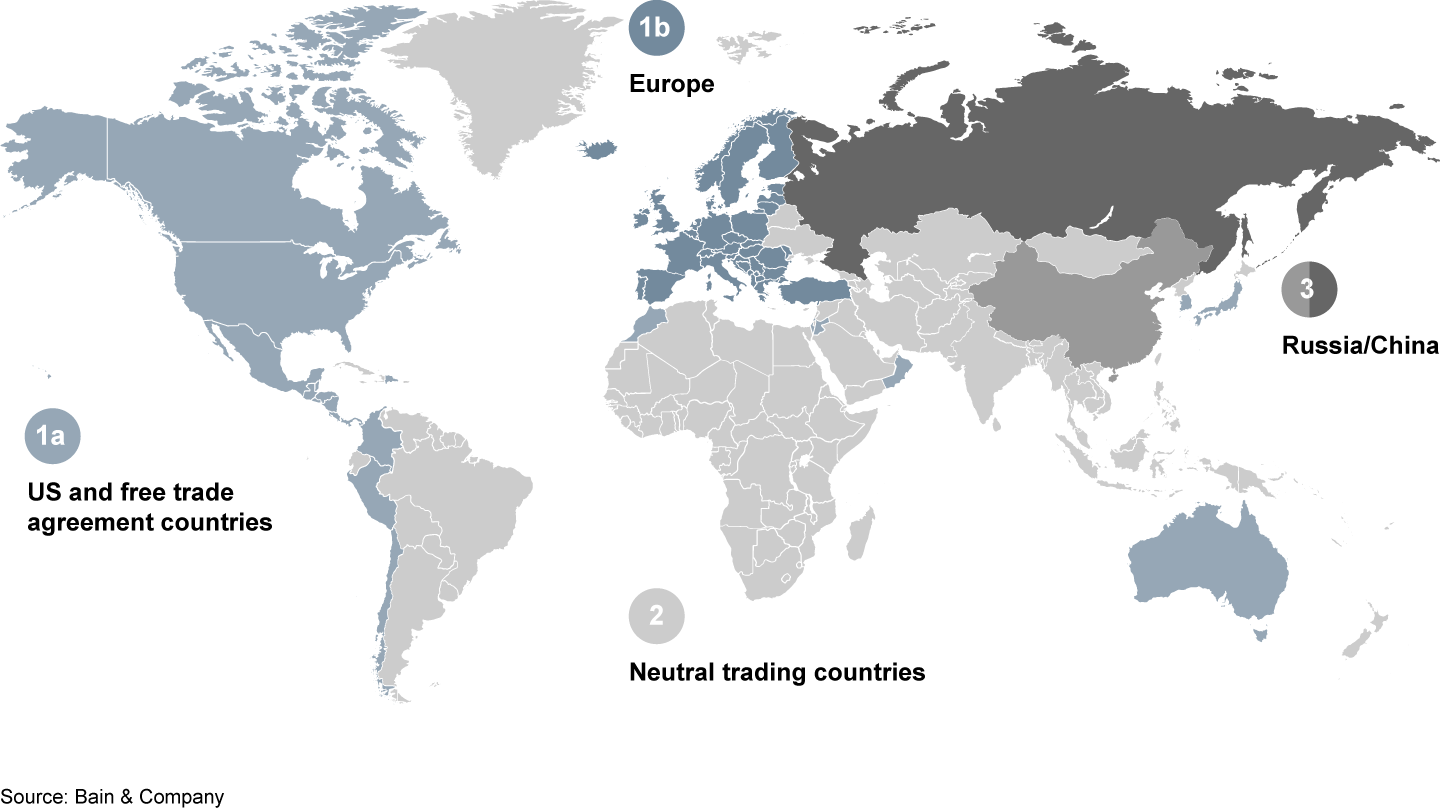
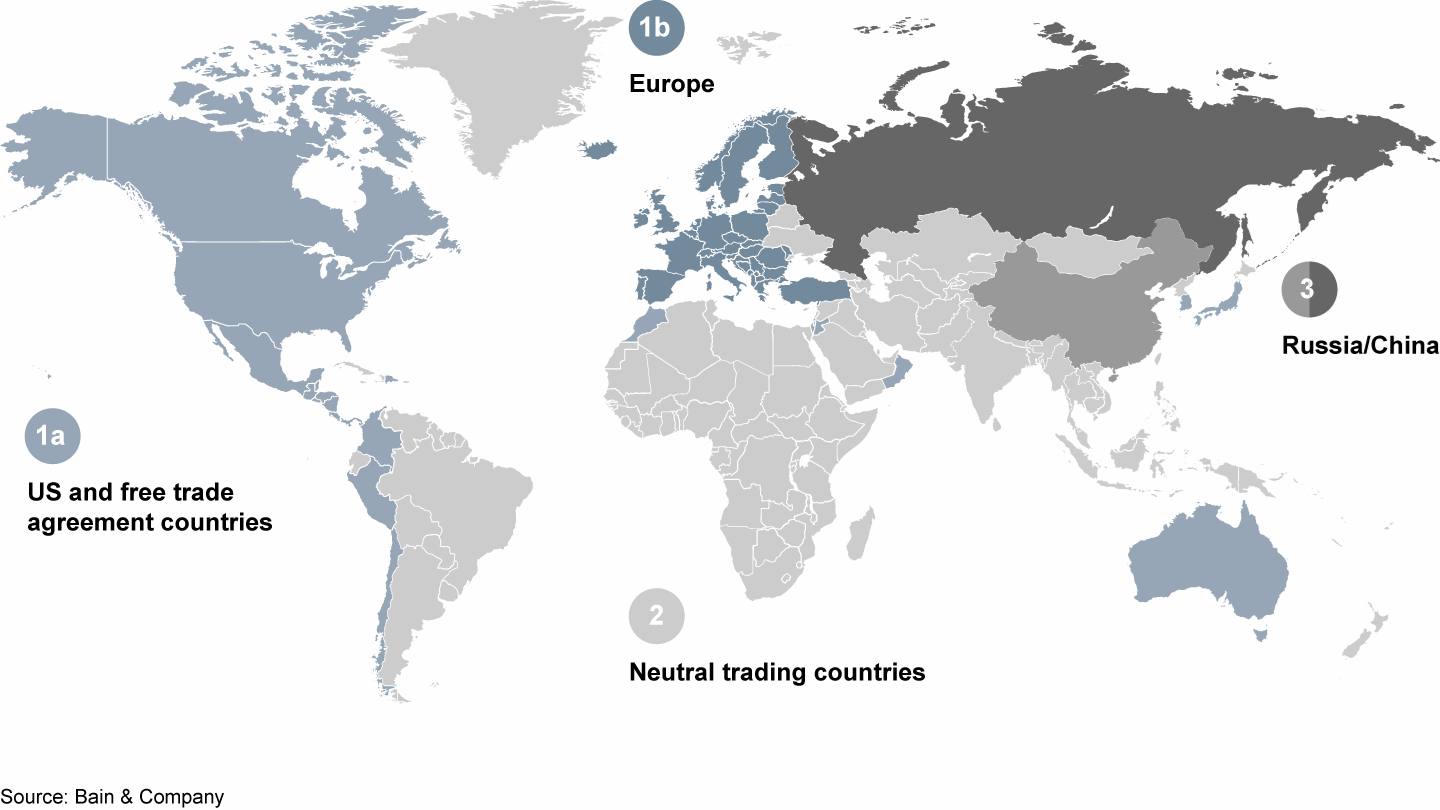
Supply-chain risk can be evaluated through multiple lenses, but our analysis identifies three key risks for companies along the EV value chain. These could also put government targets for EV adoption and emissions reduction in jeopardy. They are:
- the IRA and broader geopolitics, which relate to how much supply is legislatively required to come from specific regions, and/or how much demand may be generated by trading blocs from the same regions of supply;
- global supply-chain resiliency, which is affected by overall supply and demand, as well as geographic and supplier concentration; and
- environmental, social, and governance (ESG) concerns, including the impact of natural resources on mining and processing key minerals.
To identify potential hotspots, we assessed each of these risks across 16 critical segments of the end-to-end EV battery supply chain, from mining and processing of critical minerals through components and battery production, to end-of-life recycling (see Figure 3).
These results can be summarized as four challenges that need to be addressed:
- There is a potential global shortage of some critical minerals through to 2030, and in particular a lack of mining and processing capacity. Announced supply in the US, FTA countries, Europe, and neutral trading nations is less than expected US, FTA, and European demand. This might lead to competition for supply.
- Supply of constituent materials such as electrolyte salts and battery components such as separators that meet regional content requirements is insufficient to meet demand from US consumer vehicles.
- Geographic and/or supplier concentration is high across nearly every part of the EV value chain. That makes it vulnerable to disruption from regulation, geopolitical conflict, natural disasters including earthquakes and hurricanes, and pandemics.
- Mitigating the environmental and social impacts of battery production while growing capacity at speed and adhering to global regulations and standards, in particular for responsible mining, may prove very difficult.
Below, we look in detail at these challenges vs. risks as they stand today, as well as the key uncertainties facing the market. We consider what actions companies can take to build flexible, reliable EV supply chains with greater resilience and adaptability in the face of change.
Challenge 1 – Potential global supply shortages of some minerals
Looking only at what the IRA requires legislatively for consumer vehicles, there is likely to be more than enough supply to meet US consumer vehicle demand from IRA-compliant (US and FTA) countries across most minerals, including lithium, nickel, and cobalt (see Figure 4) in 2030. While sufficient cobalt supply has been announced, there is a slight shortfall in announced cobalt processing capacity, raising the risk slightly for that commodity.
However, US consumer vehicle makers are unlikely to be the only manufacturers to prefer supplies from the US/FTA trading bloc. Looking at all EV demand from the US, FTA countries, and Europe, volume from within these—as well as from neutral areas—is not sufficient. A serious gap emerges in processing capacity: Only 65% to 75% of the processing capacity required to meet lithium, nickel, and cobalt demand from the US, FTA countries, and Europe will be available in these regions plus neutral countries by 2030.
Based on currently announced capacity that has moved beyond the feasibility-study stage, global supply of these key minerals (including supply from Russia and China, which is not IRA-compliant) is expected to be insufficient to meet global demand by 2030. Without technological advancements or new supply from existing mines, there could be limited opportunity to increase supplies significantly. It takes on average more than six years to bring new mining capacity in lithium online, and more than four years for nickel and cobalt once feasibility studies are completed.
Challenge 2 – Limited regional capacity to produce some constituent materials and components
Announced supply was assessed in two categories: constituent materials (cathode binders and electrolyte salts) and components (electrolytes and separators). Both produced a mixed picture—announced supply of binders and electrolytes appears to be sufficient to meet the needs of the US consumer vehicle market, while electrolyte salts and separators do not (see Figure 5).
Announced Inflation Reduction Act–compliant capacity for electrolyte salts and separators is insufficient to cover expected US consumer demand
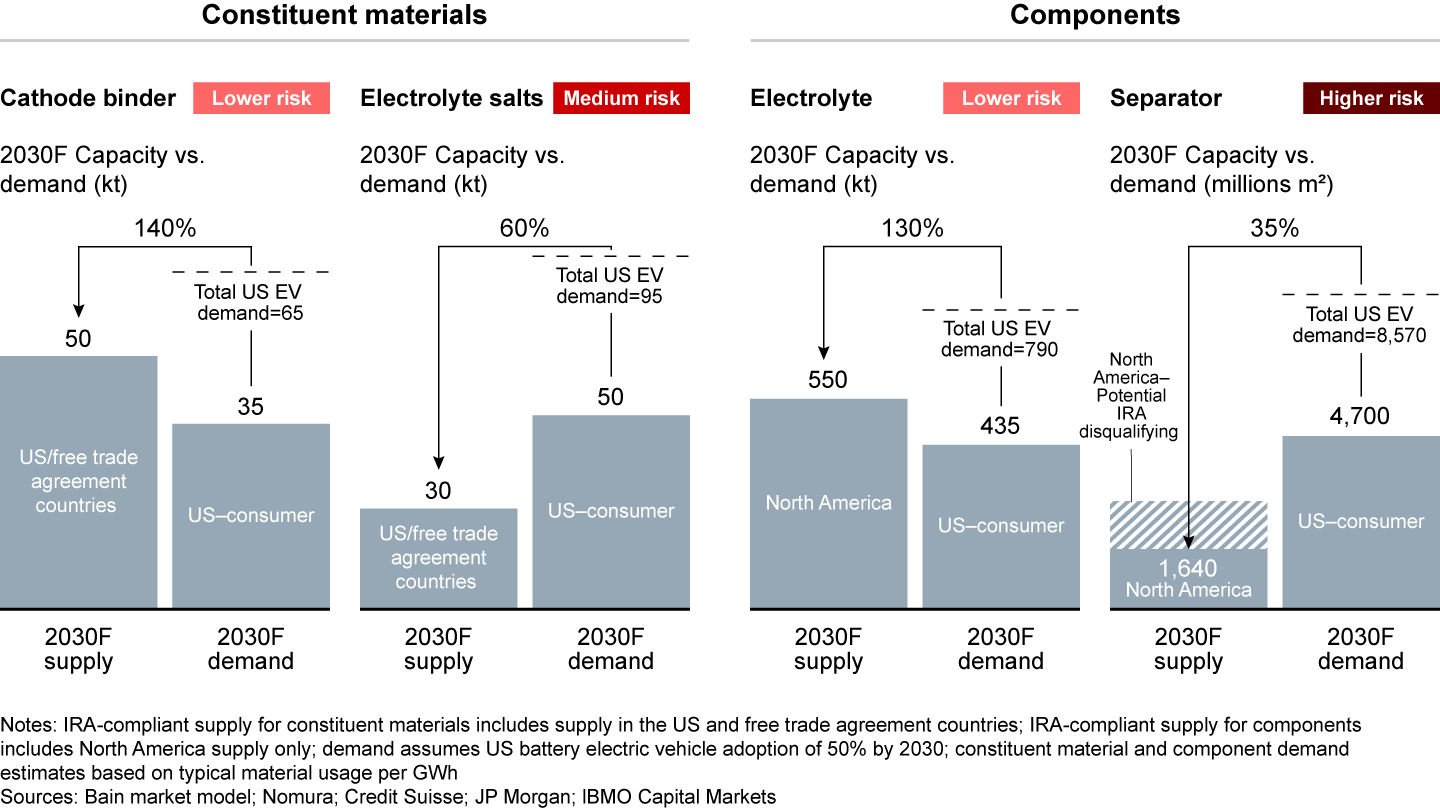
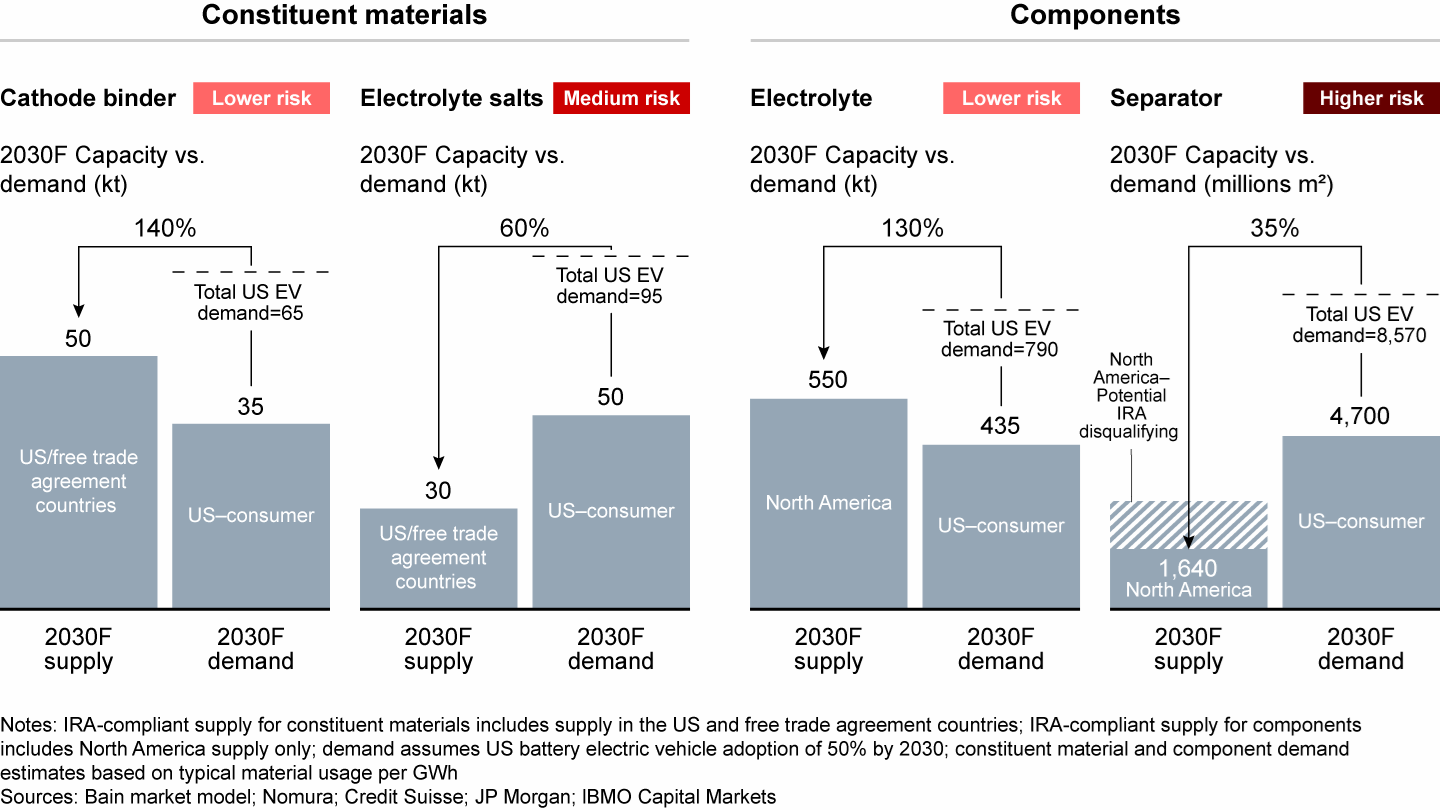
Even where announced IRA-compliant capacity is enough to meet expected demand, a gap remains between what is planned and what is operating or under construction today. This creates execution risk, as projects to supply some important constituent materials and components have yet to be implemented (see Figure 6).
Looking at individual materials and components, close to 60% of the announced capacity in cathode binders is already operating. By contrast, electrolyte salts and electrolytes have less than 50% of their announced capacity either operational or under construction. Separators, which show a large gap in announced supply, also have no new capacity under construction yet, increasing the risk for that component.
Construction of many projects in electrolyte salts, electrolytes, and separators has yet to begin
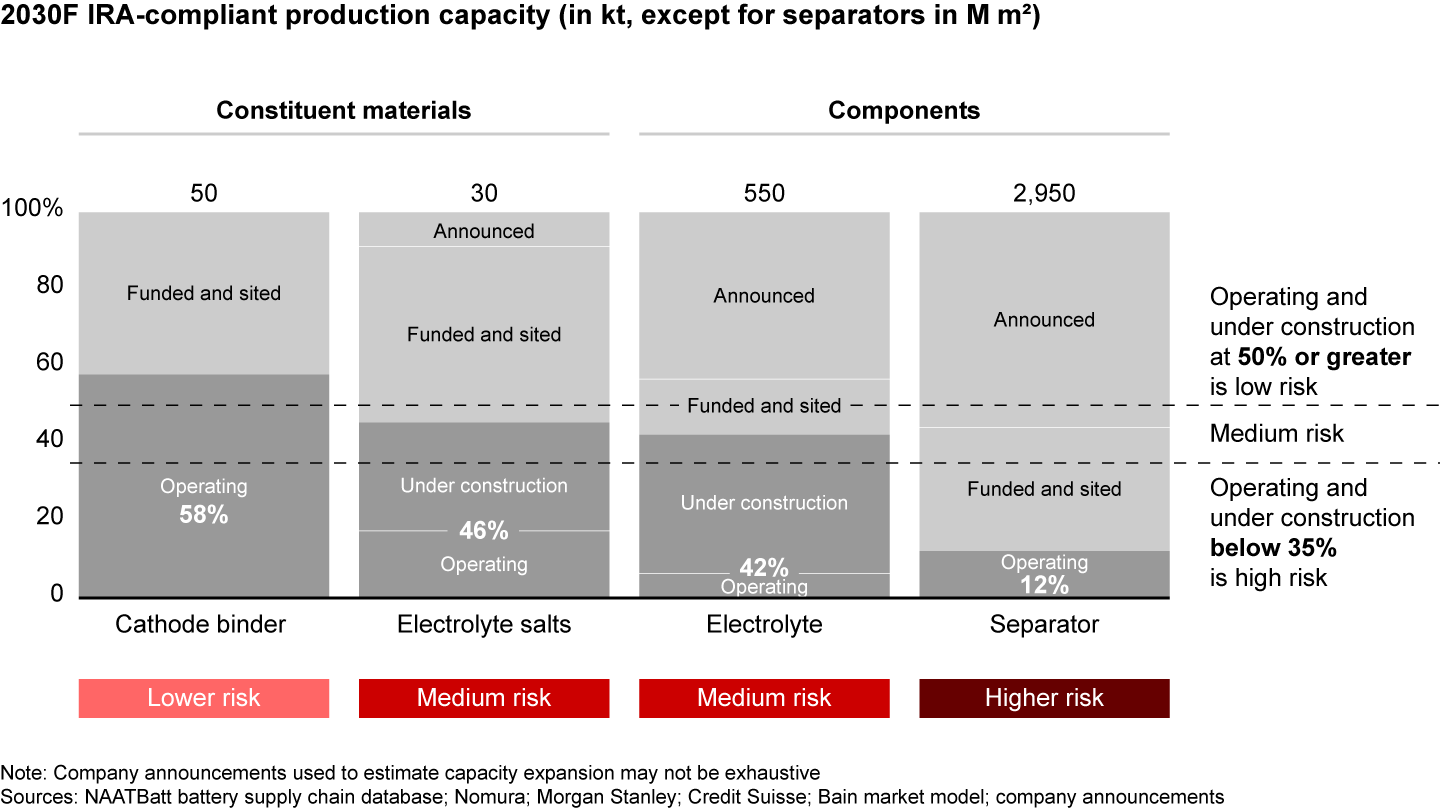
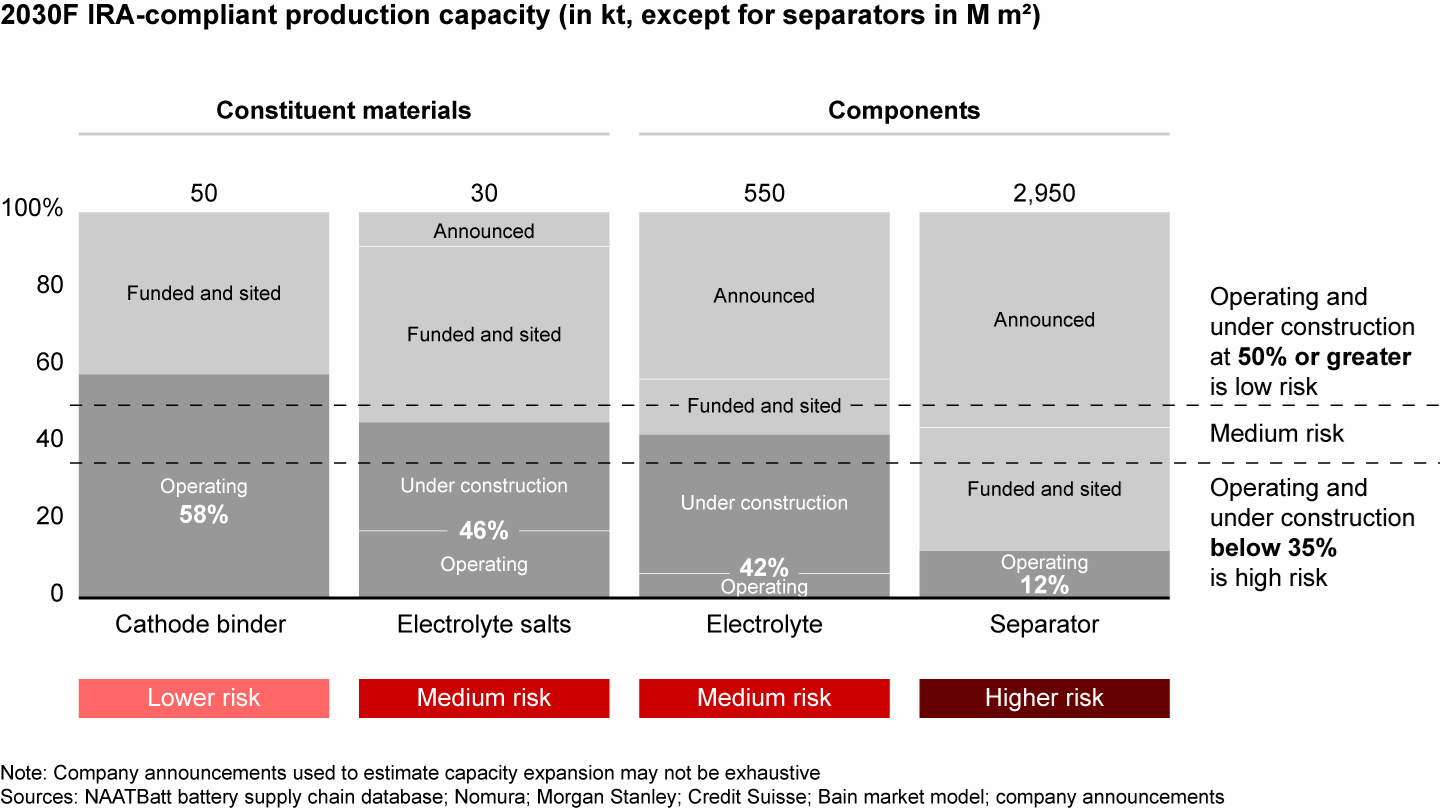
Overall, regional supply of constituent materials and components from the US, FTA countries, and European nations is far short of expected demand across those regions by 2030 (see Figure 7). Electrolyte salts show the biggest gap between supply and demand, followed by cathode binders, and then electrolytes. The position on separators is better, but a proportion of supply from North America may not be IRA-compliant because the country in which the company’s controlling organization is based makes it ineligible.
Announced supply from the US, FTA countries, and Europe is insufficient to meet regional demand for some materials
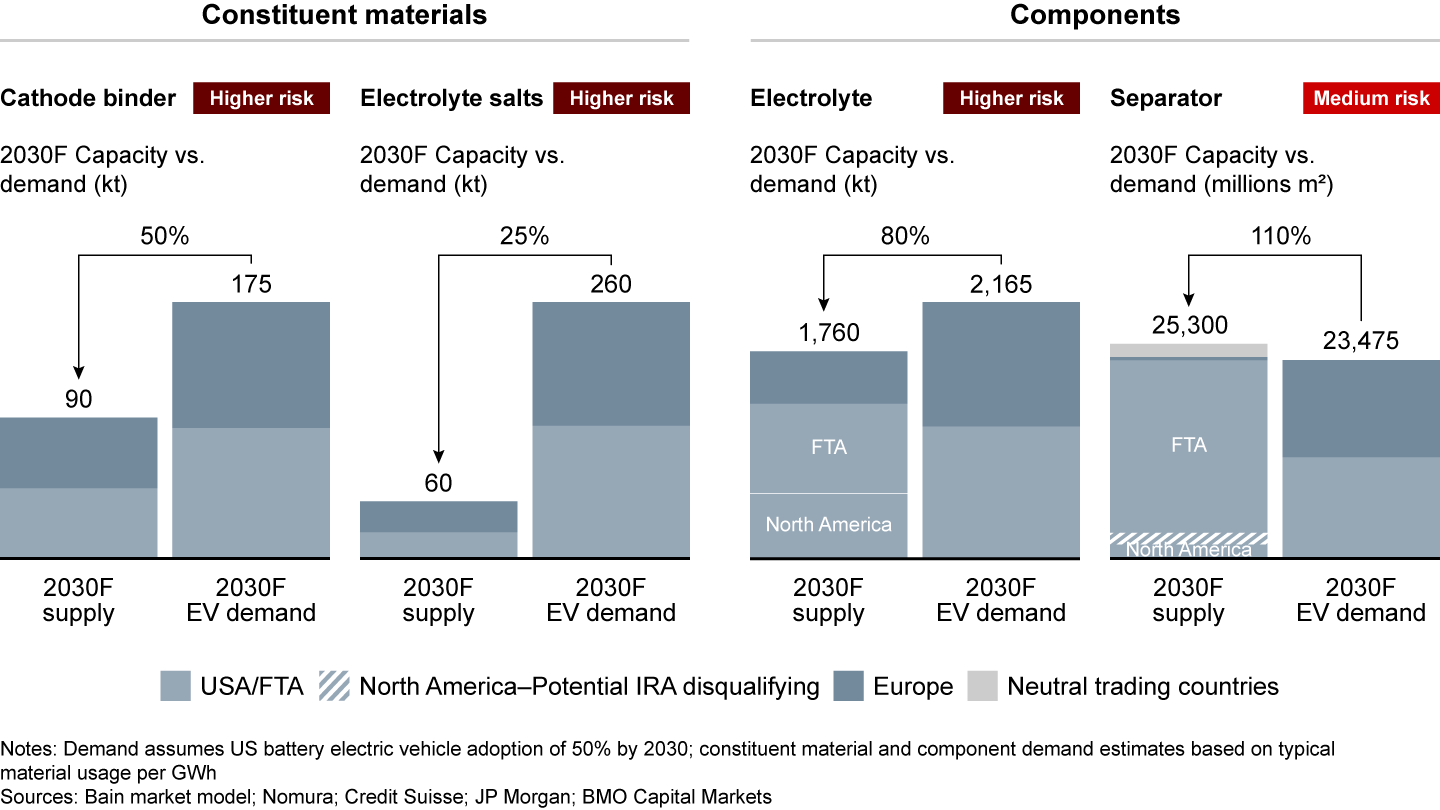
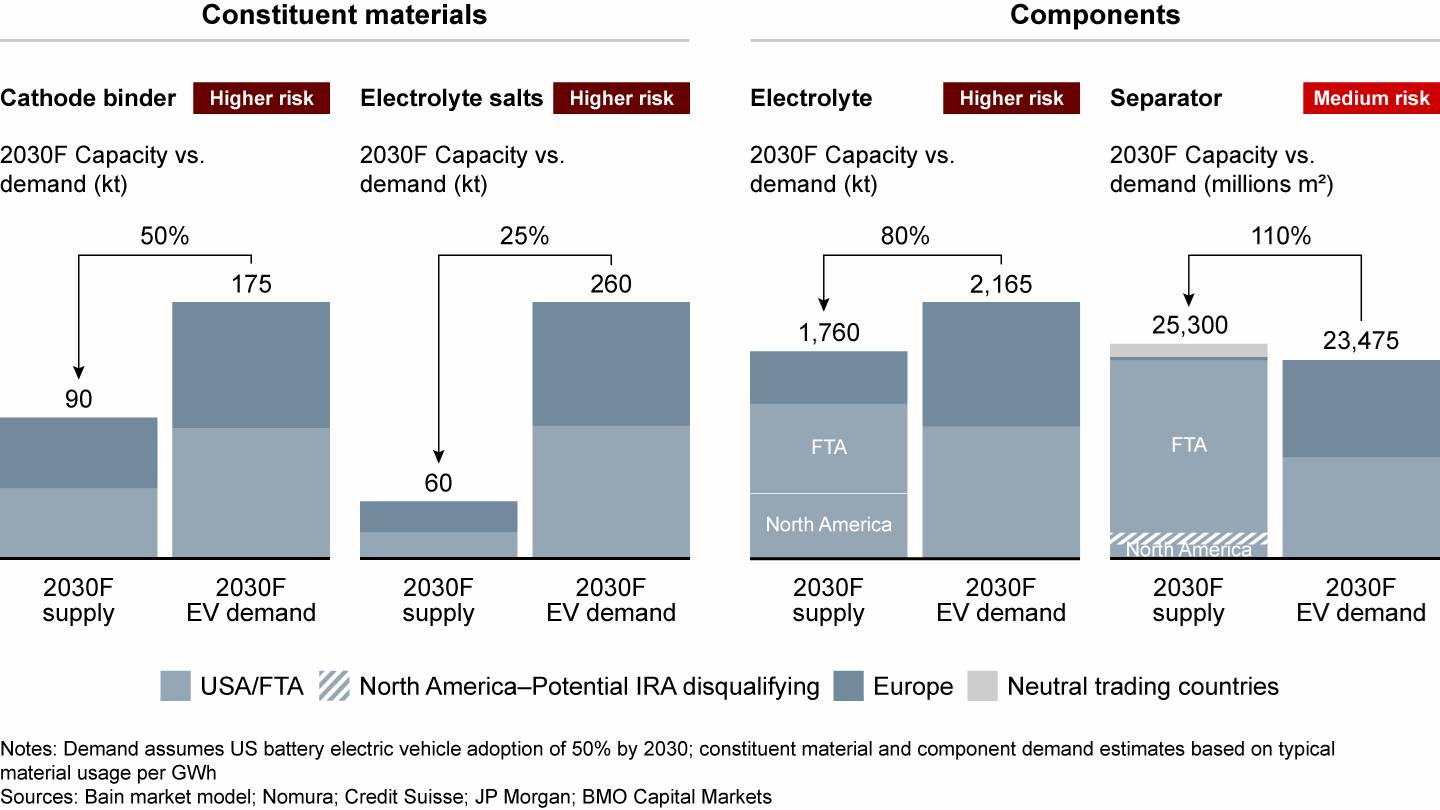
When all geopolitical and trading regions are included, global supply comfortably covers demand (see Figure 8). However, this would leave original equipment manufacturers (OEMs) and suppliers heavily reliant on Chinese and Russian capacity.
Announced global supply comfortably covers demand across all four products
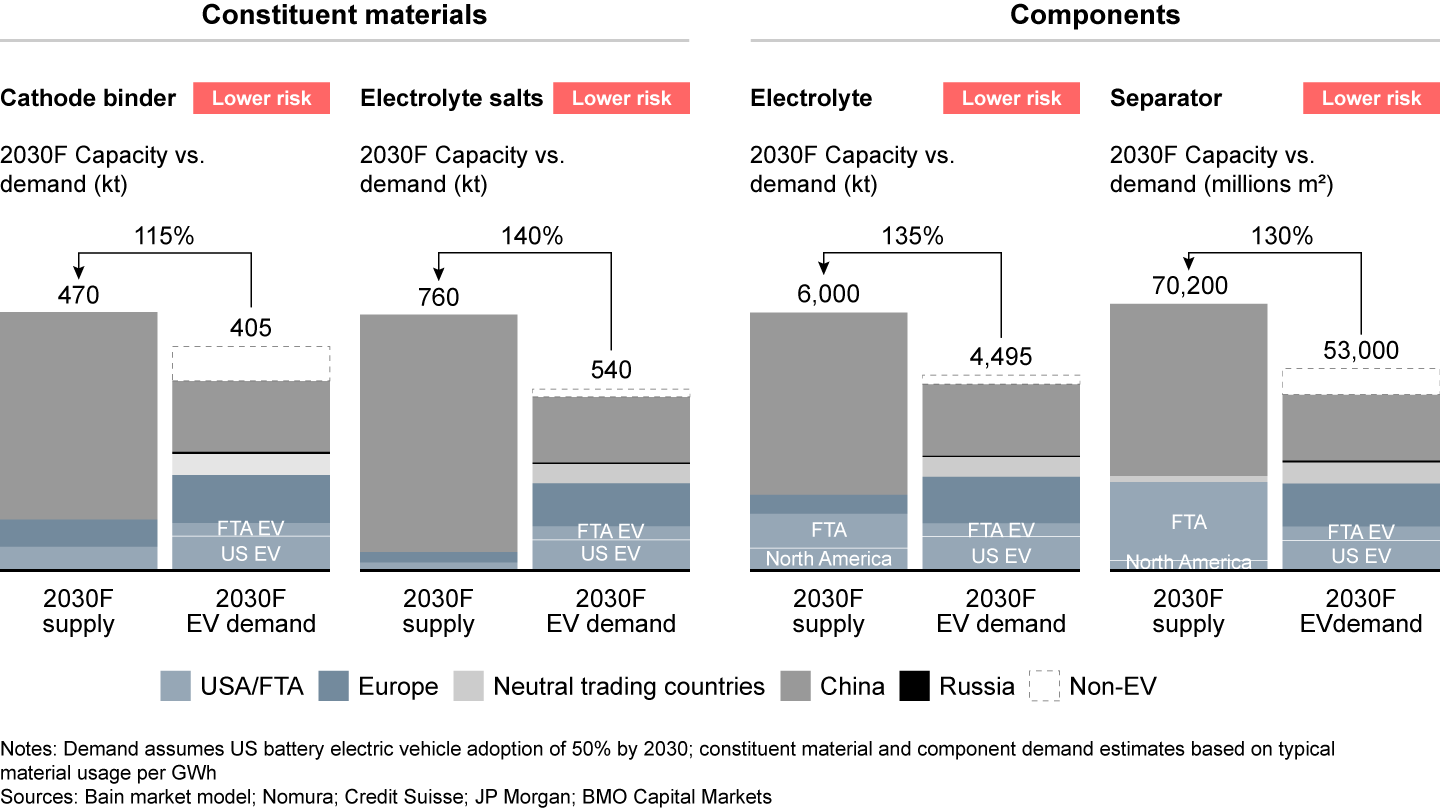
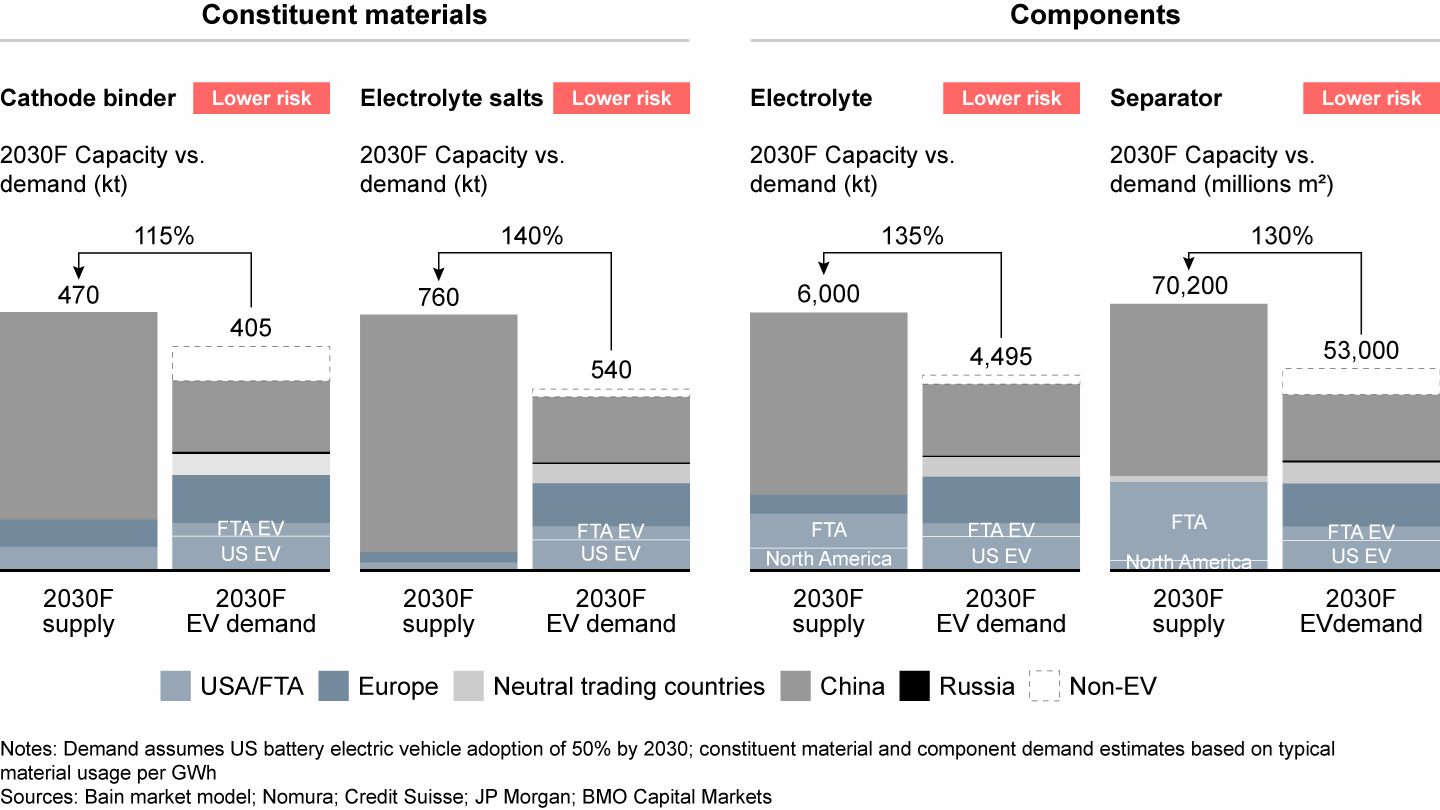
Challenge 3 – High geographic and supplier concentration
The geographic concentration of suppliers of constituent materials and components is significant. As well as the risk posed by trade or political disputes between countries, the Covid-19 pandemic showed how supply chains can be disrupted by shutdowns in markets where supply is highly concentrated. Extreme weather events, which are becoming both worse and more frequent due to climate change, could result in similar shortages.
Separately, there are potential supplier concentration risks along the value chain. In electrolyte salts and separators, for example, the top three suppliers provide 70% to 80% of the announced capacity. Concentration is less in cathode binders and electrolytes, but the top three suppliers still provide around 50% of the announced supply (see Figure 9).
High geographic concentration coupled with limited supplier diversification introduces a single point of failure risk for some supply steps
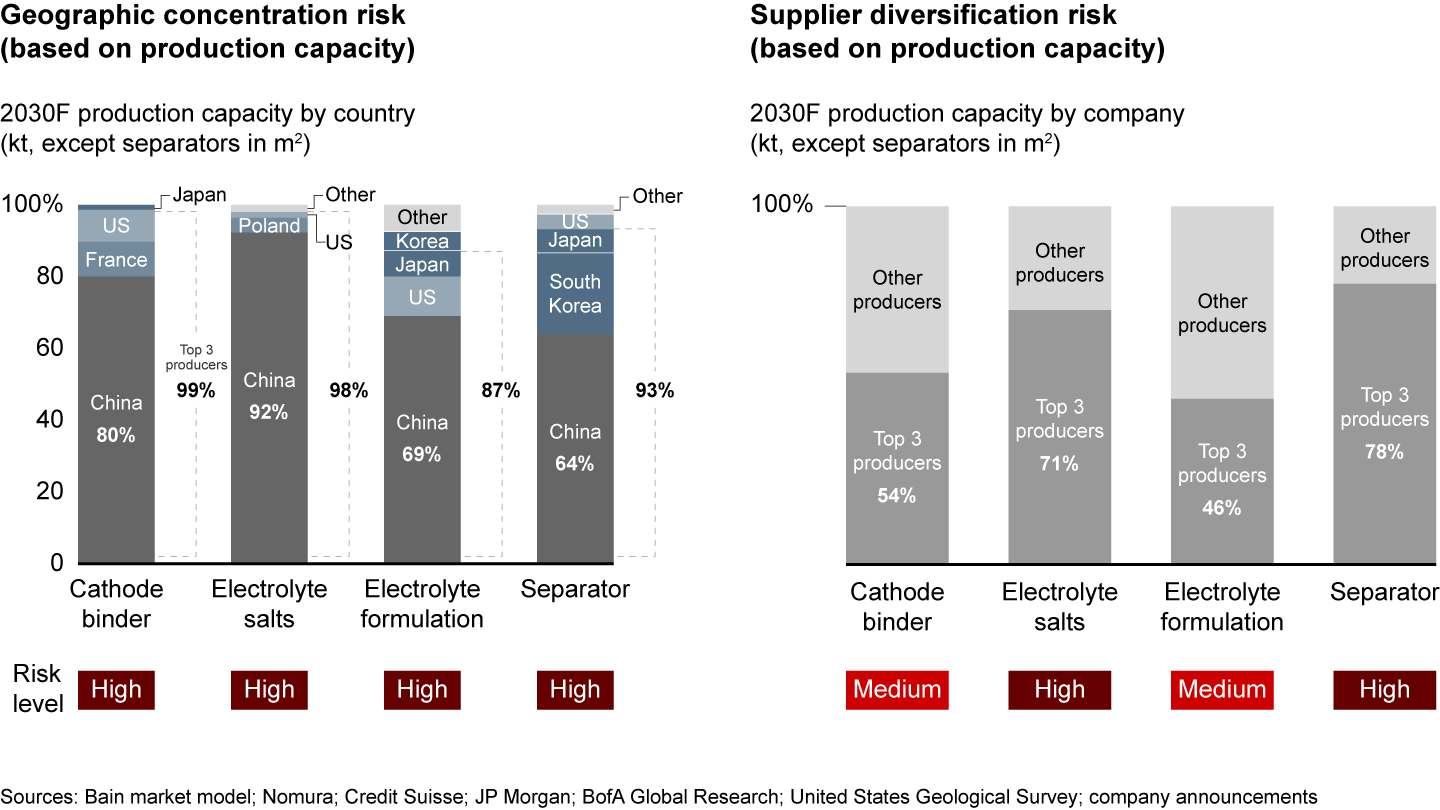
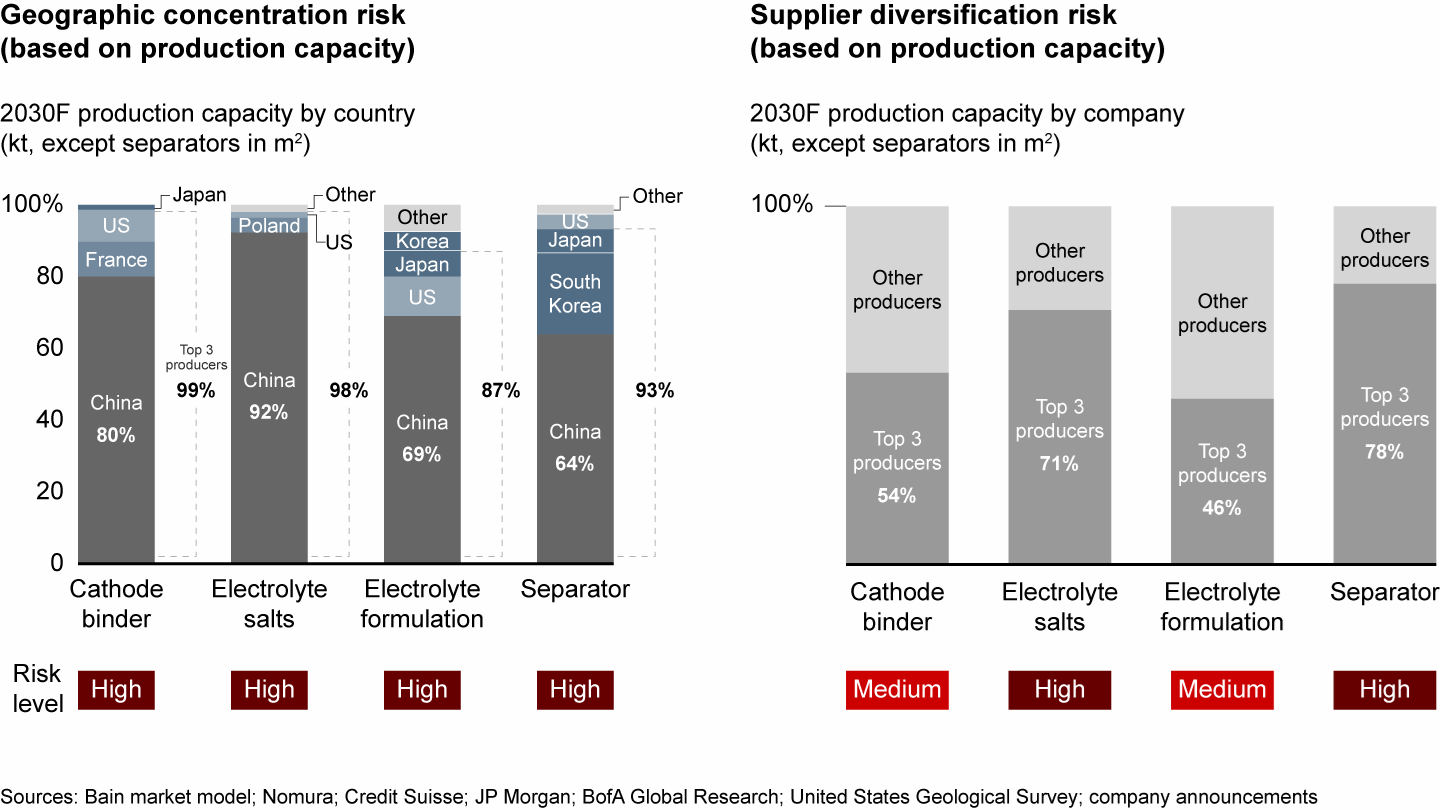
Challenge 4 – Aligning the need to grow capacity with ESG requirements
In the EV supply chain, strong environmental and social risks around responsible mining practices exist, including carbon emissions as well as commitment to broader ESG issues such as human rights. One example is increasing demand from investors and consumers for companies to be transparent about issues such as child labor and emissions across all their inputs and supplier practices along the value chain.
The transition to EVs will also require a significant shift in jobs and training in the existing domestic car industry. Future subsidies and government support for new investments (especially battery and OEM investments) may be at risk unless there is sufficient community investment in training and local hiring.
When it comes to the critical battery components of lithium, nickel, and cobalt, there are some significant ESG risks. One is human-rights abuses—the Democratic Republic of Congo is the world’s biggest cobalt producer, and recent research has found forced and child labor still occurs in some of its mines, despite changes made in response to investor and customer pressure.
Another comes from the greenhouse gases released during mining and processing of the minerals, as well as potential harm to biodiversity. A large proportion of the world’s reserves of all three key minerals are in biodiverse areas—around 70% in the case of cobalt mining. Recent policy developments have made protection of habitats and species higher ESG priorities. For example, the Global Biodiversity Framework agreed at the COP15 summit in December 2022 commits 196 member nations to “halt and reverse” biodiversity loss by 2030.
Given the legitimate social and regulatory pressure for environmental protection, companies will also need to proactively address measures such as limits on water use in mining if they are to get their sites up and running quickly. Failing to address ESG concerns can add risk and uncertainty in mining operations.
Three broad areas of uncertainty that will affect the market and decision making
As this risk assessment looks ahead to 2030, there is considerable uncertainty around the severity and potential outcome of each of these challenges and their impact on EV makers and suppliers, as well as on emissions-reduction targets. The four challenges described above are based on today’s best available information, but it will be important for companies in the EV supply chain and governments pursuing EV adoption and emissions-reduction targets to understand that the scale of each challenge could change drastically.
The uncertainties in addressing the identified challenges fall into three broad categories:
- supply availability, linked to execution timing of new capacity both in mining and processing of key minerals, potential advances in technology, and the total global and regional supply of constituent materials, components, and batteries;
- further regionalization of the supply chain as a result of geopolitics and government policies, including US refinements of the IRA, requirements or restrictions from other countries for localization of EV supply chains, and the level of coordination across trading blocs; and
- the strength of EV demand, which could be affected by adjacent dependencies such as the availability of supporting infrastructure including charging points, the take-up of alternative technologies (for example, solid state batteries), and total EV cost compared with ICE vehicles.
All of these elements will alter the risk heatmap shown earlier.
It is possible, for example, that there will be a leap forward in mining technology. Techniques such as direct lithium extraction (DLE) are gaining traction, with Chile and Argentina both aiming to implement DLE between 2025 and 2030. DLE may be able to significantly increase the amount of lithium produced from a site today, through improved recovery. A surge in supply could reduce both the global and regional supply/demand gap for this resource.
At the other end of the spectrum, any delays or cancellation affecting announced mining projects in countries such as Argentina will cause greater shortages than currently anticipated.
The uncertainties are such that hundreds of different scenarios could play out over the coming years. There are three extreme but plausible scenarios that could result in EV supply chains developing very differently from the path described above:
- Drastic global conflict—where geopolitical tensions continue to rise and trade blocs harden further, resulting in the creation of fully localized or regionalized supply chains. This causes supply of materials to become more constrained and EV supporting infrastructure to be delayed due to supply-chain issues, slowing overall adoption.
- Technological supply shock—where new technologies unlock significant new supplies of critical minerals, leading to lower EV prices, faster adoption, and an overall relaxation of emphasis by governments on the need to localize the supply of some critical minerals.
- Non-EV revolution—where the IRA and other government support programs are rolled back, increasing prices and delaying adoption of EVs, due to renewed concern on debt levels within governments. During this delayed rollout, a potential alternative low-carbon technology to EVs begins to show promise, further delaying consumer adoption and government pushes.
While none of the above situations are expected to be the base case, or even necessarily likely, companies in the EV supply chain need to be aware of all possibilities and plan for a rapidly evolving and highly uncertain future.
What can OEMs and suppliers do now to build a resilient future supply chain?
The IRA has sent a clear market signal regarding EV adoption and the need to build out the required infrastructure. However, EV supply-chain participants remain in an uncomfortable position. Uncertainty clouds important aspects of the decision-making process, but no company can afford to sit still. So what can they do?
First, they should think of each investment as part of a portfolio. Some investments will work in nearly all scenarios. These “no regret” moves are typically the first investments to make. Others will be small- to medium-sized bets that create options and flexibility and will be valuable under many scenarios and/or support critical learning processes. Examples here include pilot-scale investments or smaller new capability investments. The last is big bets—one-way decisions with large capital allocation where future scenarios provide conflicting views on the potential payoffs. For these big bets, companies will need strong convictions in how they view the future, despite the inherent uncertainty.
Second, companies can no longer rely on setting a five-year plan, and then following it to the letter. In today’s environment, it is important to identify and monitor signposts that could point to a future much different from the one originally expected and adjust the strategy in real time as needed.
Third, companies need to invest in building transparent, robust, and circular supply chains. They should carry out the necessary due diligence on their inputs to clearly identify their most critical materials, where these materials come from, the risks and potential failure points of each one, and individual mitigation plans. Additionally, this transparency can allow companies to quickly alter their own internal processes to meet specific requirements in different regions where they operate.
Fourth, companies should think expansively about how they can build partnerships and strike long-term agreements to help limit the impact of some uncertainties and derisk large capital investments. For example, battery recyclers can build partnerships with OEMs, battery manufacturers, and other electronics providers, to both build their future supply of batteries and ensure they have buyers for the recycled materials at economically feasible price points.
Finally, it is important to invest in community and government outreach. On the government side, companies need to clearly understand current EV policies and seek to address policymakers on issues of particular concern, look for win-win opportunities, and try to anticipate future policy shifts. Locally, all large capex projects require community support to some degree, and this is especially true in mining. Companies need to invest in community outreach to build mutually agreeable outcomes, whether through local investment, protection of critical resources, or job training and economic revitalization efforts. This will help ensure smooth capacity buildup in the future.
Shaping the future of the global EV supply chain
The introduction of the IRA has seen the US leap forward in incentives for the energy transition, with tax credits for EVs and measures to localize the battery supply chain both key. The benefits in reducing future emissions are undeniable, and with other countries likely to regionalize more of their EV supply chains, companies can no longer sit on their hands. The precise direction the global EV market and supply chain will take is unclear, but OEMs and suppliers cannot wait to make their no-regret moves or consider their big bets. They should begin building the agility that will allow them to successfully compete for limited resources, without delay.

About RMI
RMI is an independent nonprofit founded in 1982 that transforms global energy systems through market-driven solutions to align with a 1.5°C future and secure a clean, prosperous, zero-carbon future for all.